The Google Nexus 6P Review
by Andrei Frumusanu on December 16, 2015 8:00 AM ESTSystem & CPU Performance
The Nexus 6P comes with a Snapdragon 810 designed by Qualcomm. This is a big.LITTLE 4x A53 @ 1.55GHz + 4x A57 @ 1.95GHz SoC. As we’ve hopefully come to be very familiar with the chipset over the last couple of months, the key characteristics with which the 6P can differentiate itself from other Snapdragon 810 devices is through software optimizations. In particular the fact that the Nexus 6P comes with Android 6.0 Marshmallow should allow it to be able to showcase some improvements which we’ll dive into a bit later.
First we start by comparing performance of some of our browser-based benchmarks. These are predominantly Javascript tests which require large single-core performance out of the device’s SoCs.
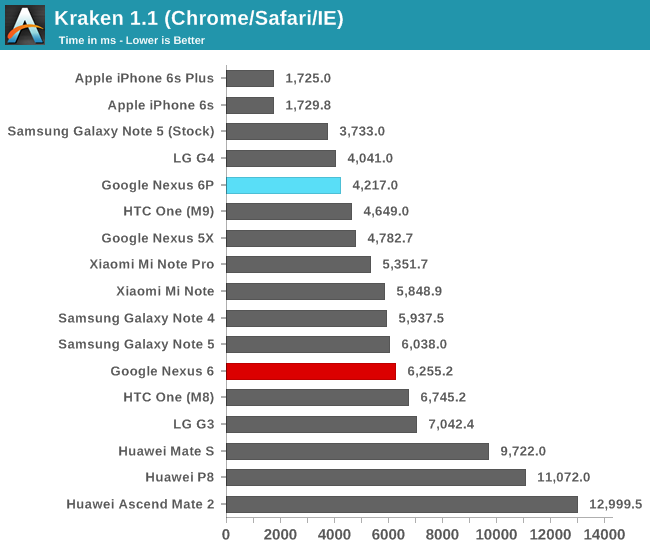
In Kraken the Nexus 6P is able to showcase a very good score that’s only beat by, oddly enough, the LG G4. As we’ve come to discover over the past year OEM browser libraries play a large role in device performance, even though we’re using the same Chrome build across different devices we see large differences in performance even within devices who employ the same SoC. It’s relatively unnerving to see this fragmentation in the ecosystem and in particular Chrome performing so differently across devices.
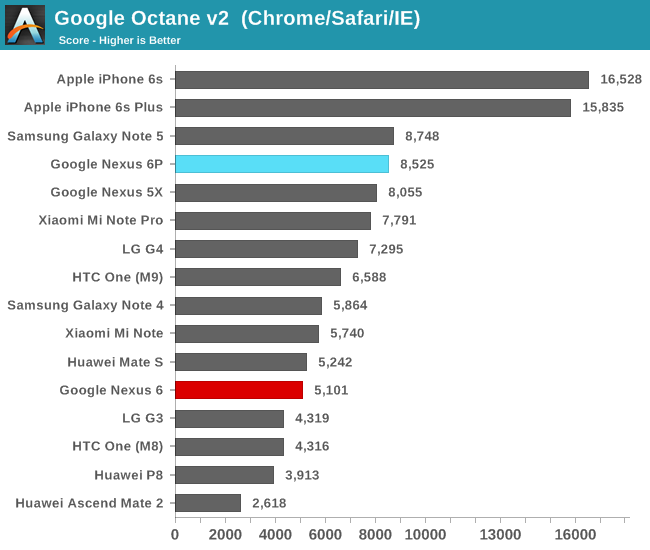
In Octane the Nexus 6P again performs very well, this time again beating our other devices such as the HTC One M9 or the Xiaomi Mi Note Pro. Among Android devices, only the Galaxy Note 5 - which on Octane is able to show equal performance as it does in its optimized stock browser - is able to beat it.
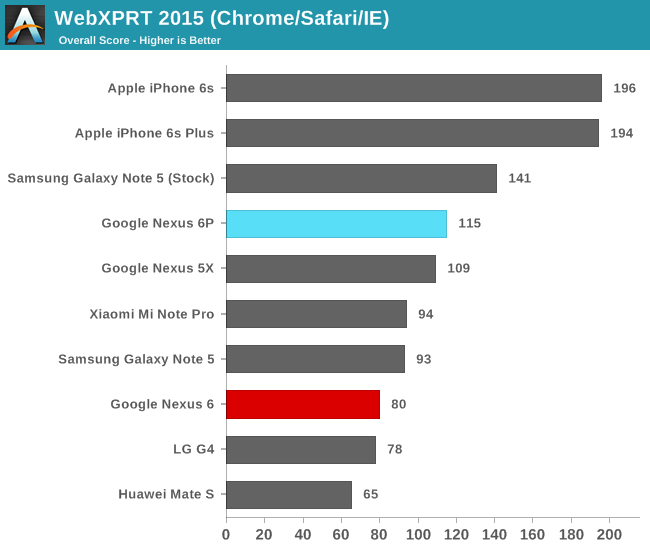
On WebXPRT again we see the 6P performs extremely well among Android devices, only being able to be beat by Samsung’s Exynos 7420 devices in the stock browser.
Continuing onto our system benchmarks, we start with Basemark OS II 2.0 from Basemark (formerly Rightware).

In the web test the Nexus 6P is yet again found at the high-end of the charts as it is able to provide good numbers. As we’ve seen in reviews such as on the Mate S it’s not necessarily raw performance that is demanded in these tests but also performance latency which plays a big role.
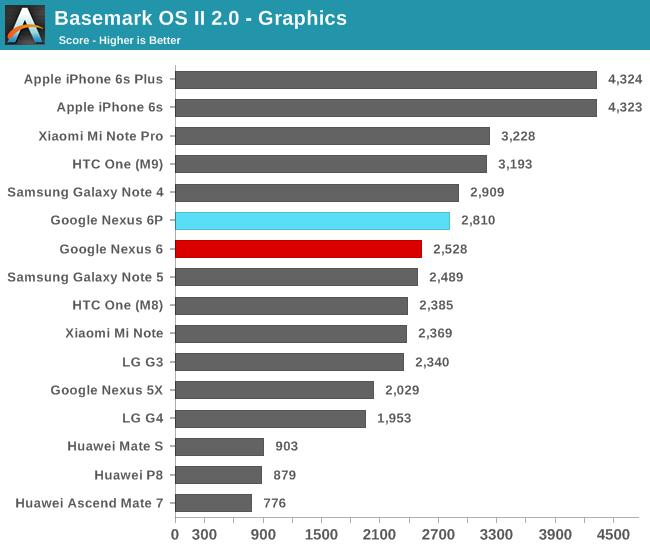
The graphics sub-test of Basemark has always been kind to the Adreno GPU so here again we see the Nexus 6P perform well, although not quite up to par with the other Snapdragon 810 devices we’ve tested in the past.
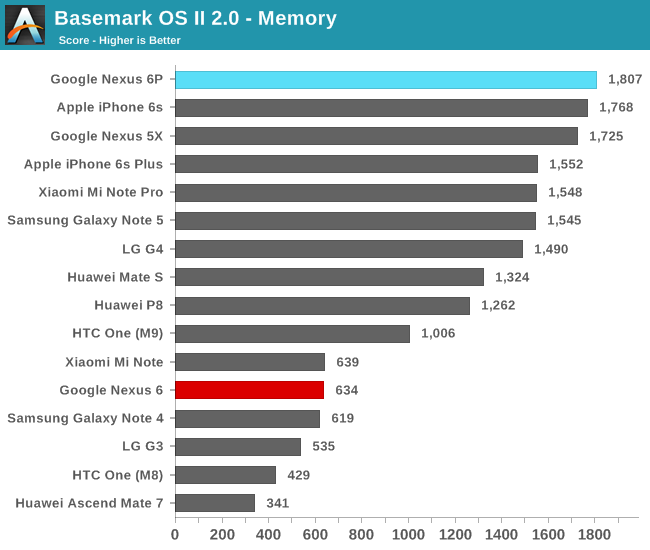
The Nexus 6P comes in a surprising first place on Basemark OS’s memory test. Again this is a mainly NAND-limited test but in contrast to our other synthetic test, performance and access patterns try to simulate more real-world applications.
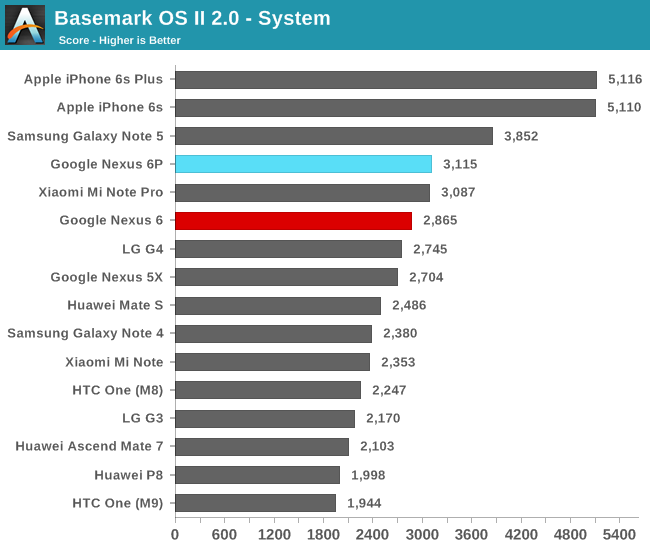
While the other tests try to test more realistic workloads, the system benchmark is all about measuring peak performance in a given set of scenarios. Here the Nexus 6P fares similarly to the Xiaomi Mi Note Pro but falls behind Exynos 7420 devices such as the Note 5.
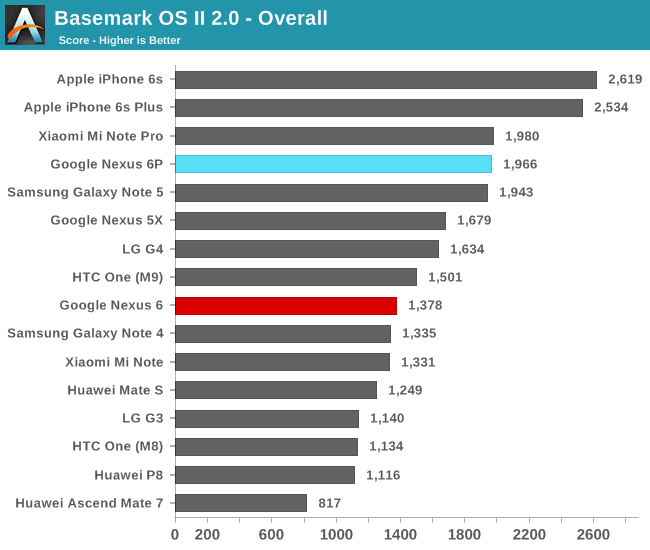
While I’m not a great fan of overall aggregate benchmark scores, we still see the Nexus 6P among the top of today’s currently available Android devices.
Moving on to PCMark from Futuremark, we’ll use a suite of tests that not only try to mimic real-world usage patterns, but actually make use of APIs that we currently find in use by many day-to-day applications.
Starting with the web browsing test we find the application use Android’s built-in WebView container which relies on OS-dependent components.
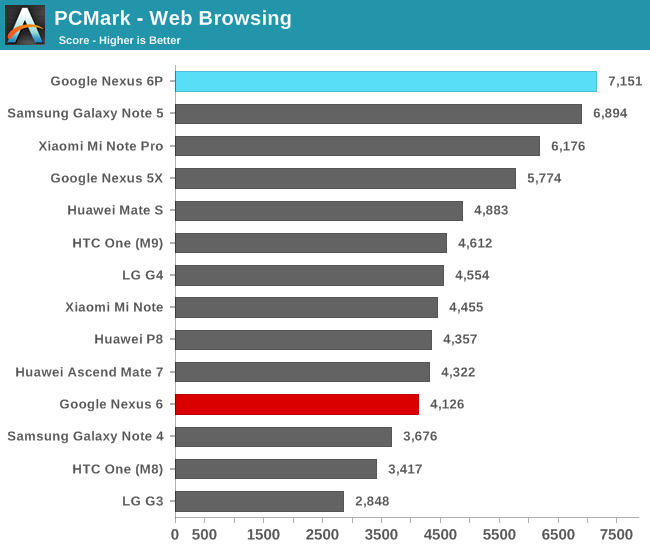
Here we see the Nexus 6P lead performance, slightly beating the Note 5. We’re also likely seeing advantages due to Android 6.0 as the Mi Note Pro, our other device with the Snapdragon 810 lags over a thousand points behind.

On the video playback score the Nexus 6P comes in towards the middle of the pack. The video test is a benchmark of both the video decoding hardware and software layers of the device, as well as the NAND speed, as fast seeking through the video is performed to test out how rapidly the device can resume playback.
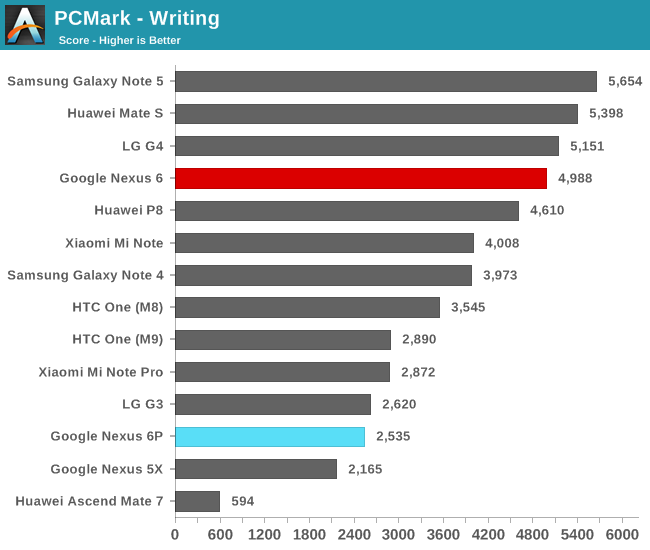
Now onto the writing test we come to one of the larger mysteries of the new Nexus 6’s performance. Both the Nexus 5X and the 6P seem to have large issues with PCMark’s writing test. The test itself consist of text manipulation and some file I/O, but most importantly it’s that this is purely a Java based test. Due to the way Android is architected, this means the code is handled and executed by the Android RunTime (ART). Futuremark have done a fantastic job in creating a test-case which is very sensitive to performance differences in the runtime.
At first when seeing these scores I thought that this was a side-effect of Android 6.0’s new big.LITTLE optimizations (which we’ll get back to in a later section), but even after turning those settings off the scores remained the same. After testing some other Java-based benchmarks I came to the conclusion that this has to be a software issue.
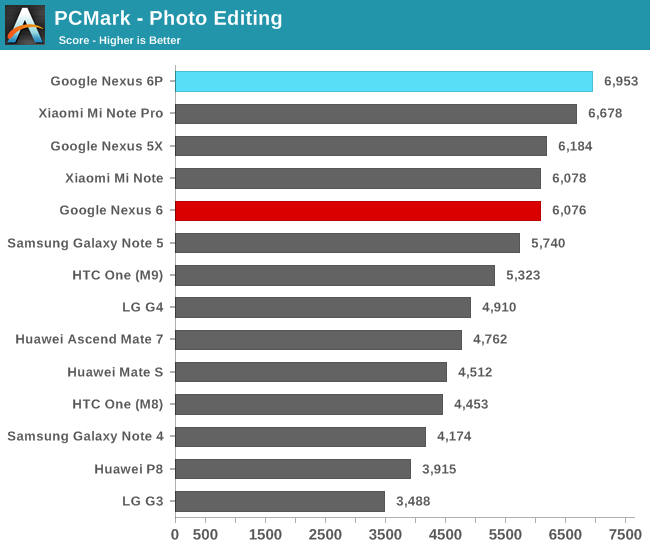
The photo editing uses RenderScript kernels to apply image processing on a set of pictures. With help of a powerful GPU the Nexus 6P performs top of the class
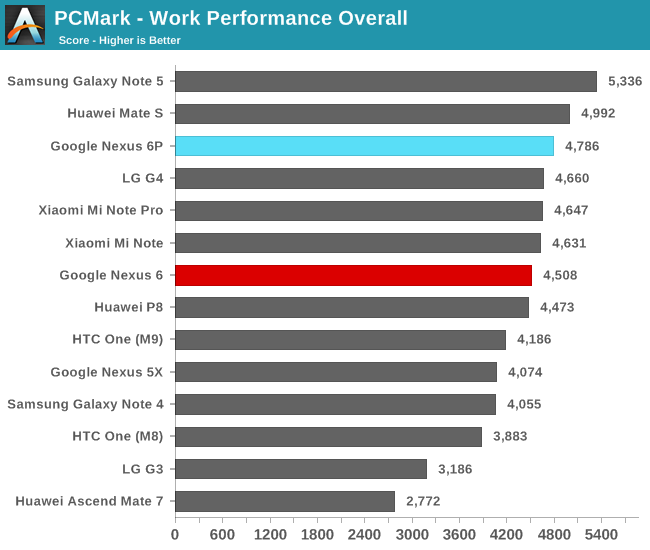
Due to the disappointing writing sub-score the Nexus 6P ends up third in the overall PCMark work performance score. Nevertheless, this is a good showing for the Snapdragon 810 device as it manages to slightly beat the Mi Note Pro and the HTC One M9.










219 Comments
View All Comments
tipoo - Wednesday, December 16, 2015 - link
What was tin hat about that?3DoubleD - Wednesday, December 16, 2015 - link
The problem of competing against the 6S is that Apple was the first to produce a custom 64-bit SoC design on 16 nm FF. Samsung released the first 16 nm FF design, but did so nearly a year ago with a stock BIG.little configuration. They saw massive gains in efficiency purely from the impressive operating voltage and leakage improvements that FF transistors provide. No one else has had access to 16 nm FF until Apple released their 16 nm FF custom SoC. It completely dominates the stock ARM non-16 nm FF SoCs due to design and process advantage and handily beats Samsung's 16 nm FF stock ARM SoC on better design alone.No manufacturer outside of Samsung has the ability to compete with Apple on this level (bleeding edge manufacturing and SoC design), but I can't say Samsung really dropped the ball either. This year's Exynos was plenty fast and efficient to sell premium devices and it performed well against the iPhone 6, which it was in competition with. If only they didn't drop the ball with the small battery capacity they could have had a killer phone.
Next year Samsung won't have the luxury of being the only player with 16 nm FF on Android, so they'll need to step up their game with SoC design, but I don't actually think beating Apple's SoC performance is very important for selling phones. The S6 had great SoC performance and it wasn't an astounding sales success. Thankfully, with 16 nm FF going mainstream next year the rest of us will have access to much more efficient SoCs, even if SoC design continues to stagnate, without the premium price gouging from Apple or Samsung.
grayson_carr - Wednesday, December 16, 2015 - link
Does the benchmark performance of A9 really translate to an improved real world experience though? I still notice that a lot of animations, like the 3D touch menu popping up on the home screen and the app switcher, run at a low framerate on the iPhone 6S Plus (the 6S is much smoother, but it also has a pretty low res screen for 2015). And to me browsing and switching between apps on an iPhone 6S Plus doesn't feel any faster than it does on a Nexus 6P.amdwilliam1985 - Thursday, December 17, 2015 - link
Got a friend who traded in 6+ to 6S+ because he can't handled the lag of iOS9.x, lol, he must be mad...Lavkesh - Thursday, December 17, 2015 - link
The lag has been taken care in the latest release iOS 9.2Djdjndjddjs - Wednesday, December 16, 2015 - link
Subpar hardware? Android has double the screen resolution and a pixel density over 100 pixels better. Then there's the fact they offer more memory at a better price and have better cameras. Saying that the iPhone is better when it still only has a 1080p LCD screen is just ignorant.johnnycanadian - Thursday, December 17, 2015 - link
Heh. Screen resolution? Certainly. More memory? Sure, Android still isn't optimized to the level that iOS is, so it needs it. 2GB is an absolute minimum for 5.x, IMHO. Cameras? Not so much; at best it's a toss-up. And SoC? There's virtually no comparison (the Note5 is the only one that comes close). So yeah, sub-par hardware. I suppose I should have written "Sub-par operating environment" so the OS issues (bloated, unoptimized code) and the less-than-stellar SoC performance would both be taken into account.I'd LOVE to go Android, but until the operating environment can match iOS' I'm stuck with Apple.
grayson_carr - Thursday, December 17, 2015 - link
"2GB is an absolute minimum for 5.x"Is it? My grandmother's Moto G 2015 with only 1 GB of RAM runs great and it's on Android 5.1.
TheinsanegamerN - Monday, December 21, 2015 - link
sending texts and calling her grandchildren are not very demanding. try to browse big websites or play games and that phone will slow to a crawl.tipoo - Tuesday, December 22, 2015 - link
Does your grandmother multitask as much as younger smartphone users? Genuine question. I had a first gen Moto G, I liked it, but the 1GB RAM really started bothering me with every app flip taking time. The third gen one can come with 2GB on the 16GB model, thankfully.On my 6S now, I can't complain about it's 2GB RAM much at all, the only things that reload are usually hours stale anyways.